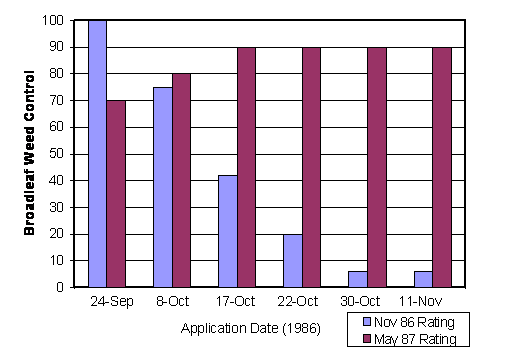Even though the drought has limited some broadleaf weed applications this month, we are now in the prime season for broadleaf weed control. Actually there is plenty of time left for good control. Nebraska research reported in 2002 showed 2,4-D and/or dicamba were far more effective in controlling dandelions and Canada thistle when applied 1 to 10 days after the first fall frost than when applied 5 to 11 days before the frost. Earlier work by Bruce Branham at Michigan State showed that even though early September applications were effective in controlling broadleaves yet that same fall, Sept applications were less effective long-term than applications made in October and November (Figure 1). Our more recent work on ground ivy shows that herbicides like triclopyr (Turflon) that are very effective on ground ivy, retain their effectiveness when applied as late as early- to mid-November (Figure 2). However, herbicides with lower activity on ground ivy were most effective from Oct 1 through Nov 1, and efficacy decreased outside of this window. This study showed that broadleaf applications should be effective when made into the first week or two of November, but control may not be seen until spring. However, herbicides that contain carfentrazone (FMC’s Quicksilver, PBI Gordons’ Powerzone and Speedzone) will still give a response in 7 to 10 days even when applied in late October or early November. Our most recent study applied in Fall of 2007 used the two most effective herbicides on ground ivy from our previous studies, triclopyr (Turflon) and fluroxypyr (Spotlight) and applied them with and without carfentrazone (QuickSilver) on Sep 15, Oct 15, and Nov 15.. QuickSilver had similar effects on both herbicides, dramatically improving short-term control from November applications (Figure 3). QuickSilver had no statistically significant effect either positive or negative on long-term control of these herbicides as rated the following May (Figure 4). Similar to our previous work, Turflon applied as late as Nov 15 provided over 90% control by the following May of the very difficult-to-control ground ivy. The take home massage is that it’s not too late to apply broadleaf herbicides and good control can still be seen from these products. If quick knockdown is required for immediate customer satisfaction, using products or tank mixes that contain carfentrazone will give a rapid burndown while not decreasing long-term control.

Figure 1. Effect of fall timing of broadleaf herbicides on control rated in Nov after application and again the following May. Note how Sep 24 applications were most effective when rated the following November, but later applications were more effective when rated the following spring (Michigan State 1986).

Figure 2. Three year averages of effects of herbicides applied in fall on ground ivy control when measured in May the following year. Turflon (triclopyr) or Vista (fluroxpyr) retained effectiveness regardless of application date, whereas the efficacy of the 2,4-D-based carfentrazone suffered outside of Oct 1 through Nov 1 window. Though 2,4D is not as effective on ground ivy as triclopyr or fluroxpyr, this stand of ground ivy was likely marginally 2,4-D tolerant (Purdue 2007).

Figure 3. Short-term control of ground ivy rated in December from Spotlight or Turflon with and without QuickSilver. Turflon and Spotlight applied in Sept or October provided adequate control by December. Combining QuickSilver with both products dramatically improved control when applications were made in November (Purdue 2008).

Figure 4. Long-term control of ground ivy rated in May after fall applications of Spotlight or Turflon with and without QuickSilver. Turflon and Spotlight applied in Sept or October provided excellent long-term control. Triclopyr applied in November provided over 90% control by May. Combining QuickSilver with both products had no statistically significant effects either positive or negative on long-term control (Purdue 2008).